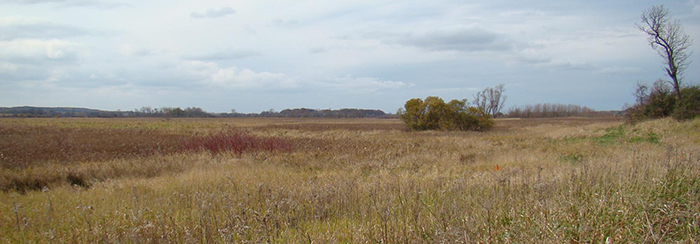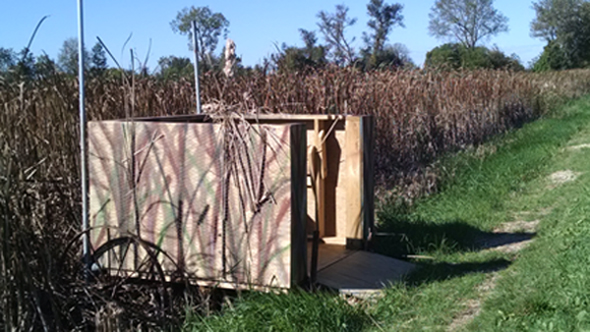Peter Helland Wildlife Area
Peter Helland Wildlife Area is a 3,580-acre property in Columbia County. It is located six miles east of Pardeeville on County Road P. The property consists of approximately 2,600 acres of wetland, 550 acres of grassland, 290 acres of forested habitat and some agricultural lands. It also contains the north branch of Duck Creek.
The property's wetlands range from wet prairie and sedge meadow to cattail marsh as well as extensive areas of disturbed marsh dominated by reed canary grass. Shrub-carr habitat with dogwood and willow is interspersed within the low areas. The uplands are former agricultural areas with scattered oak woodlots. The majority of the non-forested upland acres are managed as cover for grassland birds and other wildlife. The Springvale Wet Meadow State Natural Area is embedded within this property due to its high plant diversity and wet prairie, sedge meadow and calcareous fen habitat types.
Peter Helland Wildlife Area lies in a basin formed by the meltwaters from the last glacial period about 10,000 years ago. Native Americans used the marsh as a hunting ground, likely for prairie chicken, deer, waterfowl and small mammals. Following settlement by European immigrants and the development of drainage and dredging equipment, the marsh was partially drained to allow for farming of the muck soils. The Wisconsin Department of Natural Resources began acquiring property for the project in 1972 to serve as a goose management area, a satellite unit for the Horicon Marsh. The property is now used extensively for hunting, especially for deer, pheasant and waterfowl.
Management Objectives
Historically, the primary management objective for Peter Helland Wildlife Area – named for the late Stanton Peter Helland, longtime Natural Resources Board member and Wisconsin Dells community advocate – was to provide hunting and other outdoor recreation opportunities. As lands were acquired, marginal farm fields were converted to prairie providing additional wildlife habitat and hunting opportunities. Numerous wetland restorations occurred to create the semi-marsh habitat that is present today.
Current management objectives focus on protecting Duck Creek's watershed and managing pre-settlement vegetation types. This includes maintaining existing prairies, savannas and sedge meadows and seeking opportunities to expand these cover types. The property is managed on a landscape scale to create smooth transitions between cover types.
The property is monitored for invasive species such as black locust and garlic mustard. Prairie and savanna areas are managed and maintained through prescribed burning, mowing, farming and herbicide use to limit brush encroachment and encourage vigorous grasslands. Wetlands are managed through limited disturbance to prevent the spread of aggressive invasive species. Woodlands are managed in a manner that limits the spread of oak wilt and encourages regeneration of oak and hickory.
For more information on master planning for this and other wildlife areas around the state, visit the property planning page.
Recreation
The Peter Helland Wildlife Area offers many recreational opportunities:
- Birding
- Cross-country skiing (no designated trail)
- Canoeing
- Fishing
- Hiking (no designated trail)
- Hunting (especially noted for waterfowl, squirrels, deer, rabbits, furbearers, pheasants, turkeys [Zone 3] and mourning doves)
- Kayaking
- Trapping
- Snowshoeing (no designated trail)
- Wild edibles/gathering
- Wildlife viewing
Note: From April 15 to July 31, dogs must be kept on a leash of no longer than 8 feet.
Permissible recreational activities listed for this property may not be allowed within the boundaries of the embedded State Natural Area. Please refer to the SNA webpage for further guidance on allowable activities within SNA boundaries.
Amenities
- Bathroom – none.
- Parking lot – numerous parking lots throughout the property.
- Campground – none.
- Trails – no official trails are maintained, only staff access lanes are mowed occasionally for service and management.
- Other amenities – there is one carry-in canoe launch on a small lake on the western side of the wildlife area. This launch can be accessed from the northernmost parking on Pardeeville Road.
Reserve The Peter Helland Wildlife Area Accessible Waterfowl Blind
An accessible hunting blind in the Peter Helland Wildlife Area can be reserved for use by hunters with disabilities. The blind was made possible by a partnership between Columbia County, Lodi High School and the Wisconsin DNR. The hunting blind is located on a small, restored flowage off of Sawyer Road.
Reservations will be accepted one week in advance. Once your reservation is made, you will be provided a combination of the lock that will unlock a gate that will allow you to drive on the dike (off Sawyer Road). Hunting is limited to one hunter with a disability and one assistant.
The access to the blind is mowed so hunters can drive right to the blind; their vehicle will then have to drive down the dike and turn around near the cattle pasture. There is a parking lot on the west side of Sawyer Road just north of the dike where vehicles should be parked. The blind is on the edge of fairly deep water. Those assisting the disabled hunter will either want to bring along a skiff to retrieve decoys or keep decoys within reach of the shore. A dog is recommended for bird retrieval.
The blind can be reserved by emailing Savanna.Hartman@wisconsin.gov or calling 920-387-7860.
Maps
If you are interested in exploring this property further, you can access an interactive map.
- Download [PDF] a map of this property.
- Master Plan Maps [PDF]
Find out more about how to adopt this wildlife area.



